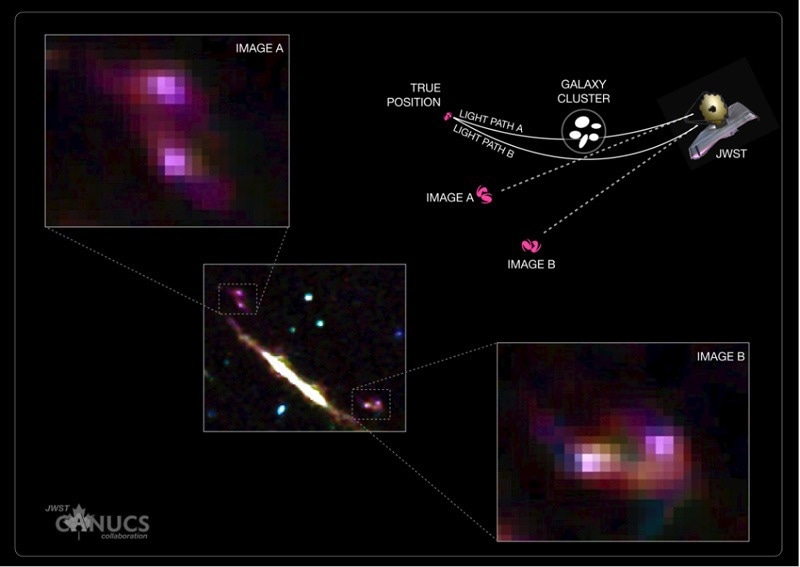Scientists have long developed theories about the evolution of galaxies, yet the intricate details of their initial formation stages remained veiled in celestial clouds of mystery.
 The merging galaxy was taken by JWST. Einstein's gravitational lensing effect produces two images A and B of the same system. This phenomenon is caused by the bending of light around the mass concentration of the galaxy cluster MACS 0417 between the observers and the merging galaxy pair. Light from the distant galaxy pair takes two separate pathways to reach JWST. This results in two images of the merging galaxy system. The purple hue of the light coming from the merging galaxies is due to the hydrogen gas within them that is made to glow by the large numbers of hot young stars forming within the young galaxies. Image Credit: KyotoU/Yoshi Asada
The merging galaxy was taken by JWST. Einstein's gravitational lensing effect produces two images A and B of the same system. This phenomenon is caused by the bending of light around the mass concentration of the galaxy cluster MACS 0417 between the observers and the merging galaxy pair. Light from the distant galaxy pair takes two separate pathways to reach JWST. This results in two images of the merging galaxy system. The purple hue of the light coming from the merging galaxies is due to the hydrogen gas within them that is made to glow by the large numbers of hot young stars forming within the young galaxies. Image Credit: KyotoU/Yoshi Asada
An international collaboration, which includes Kyoto University and Saint Mary's University, has unveiled a nascent galaxy using the James Webb Space Telescope (JWST).
This baby galaxy provides compelling evidence that its rapid expansion arises from the merger of two smaller galaxies that coalesced in the early epochs of our Universe.
The James Webb Space Telescope (JWST) images also reveal the presence of the two smaller galaxies, known as ELG1 and ELG2, offering valuable insights into the process of galaxy formation for the research team.
Because of Einstein's gravitational lensing or warping effect applied through the JWST, we can see the galaxy twice, like a desert mirage, because light reaches us from two slightly different directions.
Marcin Sawicki, Saint Mary’s University
“From studying the newly born galaxy, we learned that when smaller sub-components, such as the ELG1 and ELG2, collide and merge, galaxies can undergo intense growth spurts of star formation,” details Kyoto U's lead author Yoshi Asada.
The international team acquired JWST data, which unveiled two images of the merging galaxies. These images were created due to the gravitational lensing effect caused by the mass concentration of the galaxy cluster MACS 0417, which lies between the observers and the merging galaxy pair.
Notably, the presence of hot young stars forming within these early-stage galaxies is substantiated by the luminous glow captured in the images, arising from the ionized hydrogen gas.
Asada has collaborated on JWST data analysis with fellow astronomy scientists in Canada, including Professor Sawicki. Both researchers are active members of the Canadian NIRISS Unbiased Cluster Survey, abbreviated as CANUCS collaboration. This collaborative effort is dedicated to exploring the evolutionary trajectories of galaxies.